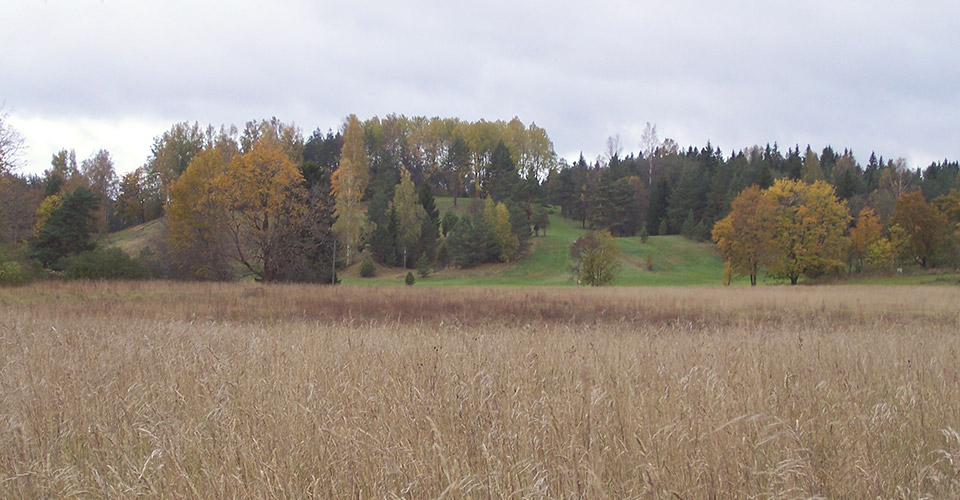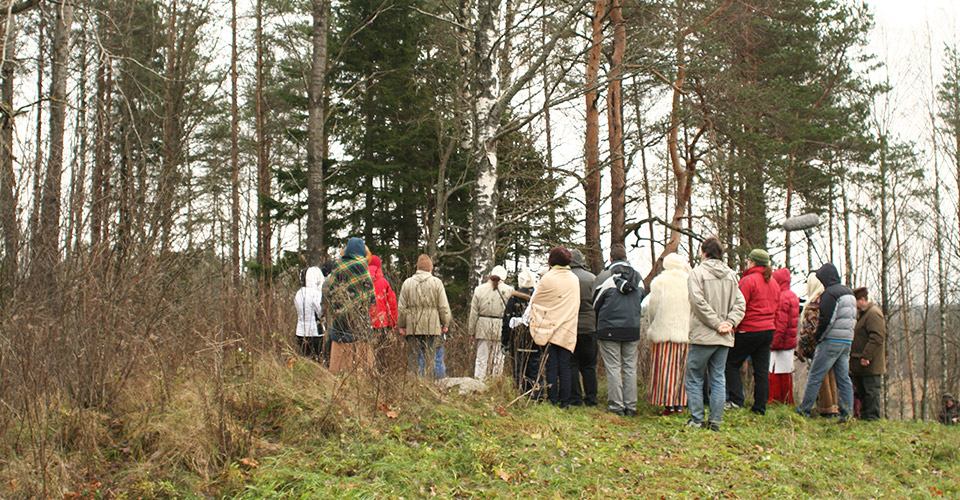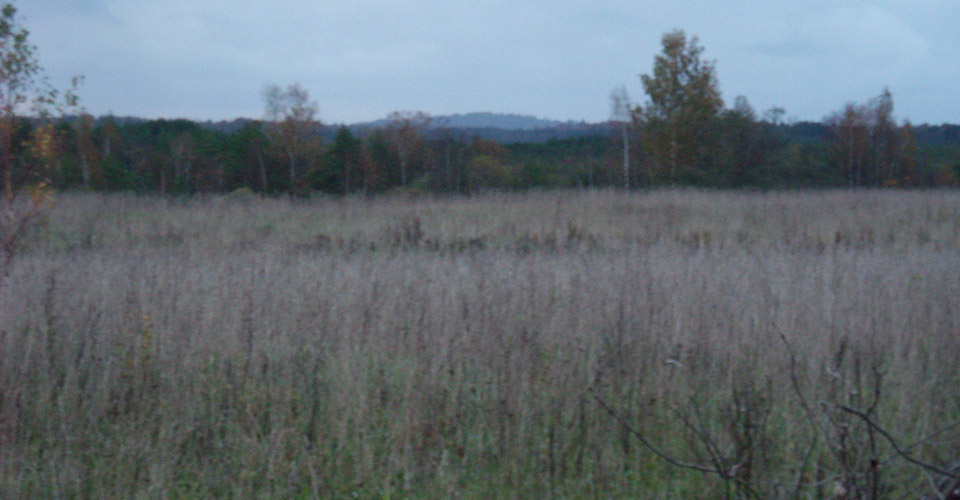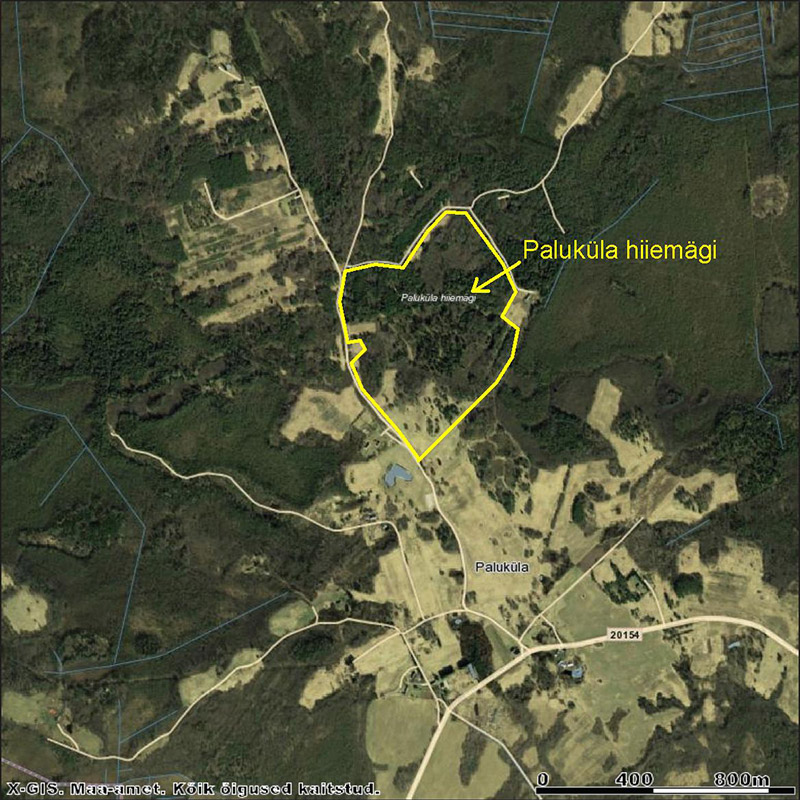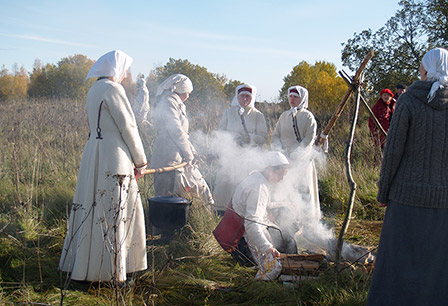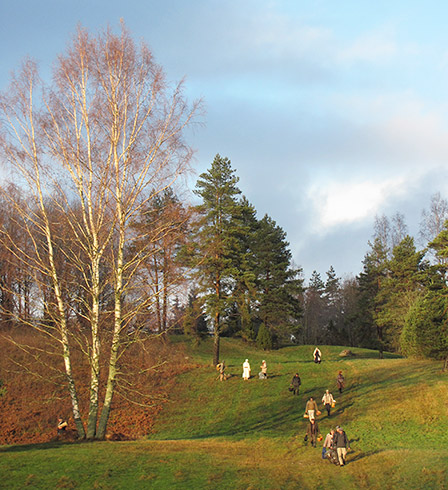사이트
Before the conquering and Christianisation of Estonia by Germans and Danes during the Livonian Crusade in the 13th century, all local villages shared sacred natural sites. Many local villages date from these times and their companioning sacred natural sites form a pattern in the landscape. 중앙 에스토니아 Paluküla 마을 영역에서 Hiiemägi라는 신성한 포레스트 힐을 낳는다 ("이들-언덕 "). Numerous local people still follow the Maausk, meaning they worship nature as a divinity. They offer the first harvest of the year to the ancestors who are associated with Hiiemägi and the trees. They also celebrate Midsummer Day at this site. According to tradition, its trees are not to be cut and the hill cannot be ploughed or otherwise disturbed.
생태와 생물 다양성
The hill forms part of a watershed area. It comprises diverse smaller heaps and valleys and is the most prominent point of the Paluküla end moraine and the kame field. Most of the hill is covered with forest. Forest habitat types include Fennoscandian herb-rich forests with Picea abies and Western taiga. The Estonian environmental registry reports protected forest bird species including the white-backed woodpecker Dendrocopos leucotos, bat species and a population of red wood ants (Formica polyctena).
위협
거의 모든 마을 사람들은 언덕이 그들에게 중요하다고하지만, 어떤 사람들은 토지 사용의 상용화로 외부로부터의 영향에 의해 분할된다, 건물 및 개발 가능한 EU의 간섭. The administration of the Kehtna municipality is set to build a sports and recreation centre on one side of the hill. Immediate neighbours are disturbed by the proposed projects that would alter their everyday lives. According to the detailed spatial plan of the centre, two ski-lifts and water-pipes for artificial-snow cannon would require excavation. 게다가, twenty buildings, plus parking areas; a volleyball square, two tennis courts and a football stadium have been planned next to the site, all within the nature conservation area.
Custodians
Followers of the Maausk regularly perform individual and communal rituals at the site. They have traditionally protected sacred natural sites by local bans of timber and agricultural practices. They continue to honour the sacred hill and some formed an Paluküla 신성한 포레스트 힐을 보호하기 위해 협회. 협회는 언덕의 후견인 역할을하고 연구하고 보존 신성한 사이트 및 다른 조직과 의사 소통을하는 것을 목표로. A supporting organisation for indigenous local nature religion, the ‘Taara의 에스토니아어 하우스와 원주민 종교’ has been registered as a religious organisation. ‘The House’ protects and revitalises sacred natural sites all over Estonia.
시력
The custodian movement is working to protect and conserve sacred natural sites such as Hiiemägi from forest cutting and building plans. 에스토니아에 걸쳐 신성한 자연의 사이트는 보호되어야하고, 자연과 문화 유산의 관리에 관계하는 기관은 관리인에 의해 보존 노력을 지원하기 위해 장착해야.
이 특별한 장소, 인간의 활동이 자연에 지배하지 않는 곳, 자연과 문화 유산을 결합하는 동시에 신성한 차원이. Paluküla이 경우, 반 개방 남쪽 언덕은 당분간 겨울에 슬라이딩에 사용될 수 있습니다, 그러나 인공 구조물이없는. 이 사이트는 또한 자연 교육 생활 예를 들어 역할을 할 수 있습니다, 폭 넓은 관객들에게 문화 보존 사례를 소개.
연합
Local custodians first made contact with the Estonian House of Taara and Native Religions. An analogical organisation in neighbouring Finland, Taivaannaula, has collected signatures in support of the hill; Finno-Ugric people have similar sacred natural sites and corresponding traditions. Estonian Fund for Nature gave legal advice and issued a statement in support. A non-governmental organisation, Estonian Greens, included the case in their book of interviews on nature protection in Estonia.
Native Americans, on their visit to Estonia, had a ceremony on the site in support of the sacred natural site. Some biologists, folklorists, and archaeologists support the case with their professional knowledge.
행동
On November 8th 2004, within period known as “Foggy Souls’ Time”, a gathering of people on the hill was able to stop the bulldozer and attract public and media attention. Signatures from all over Estonia were collected for a petition. Local custodians initiated a court case against the detailed spatial plan about a winter sports centre and including sky-lifts. The construction permit was withdrawn, but the plan was not forgotten. The case now lies under authority of the European Court of Human Rights. Local custodians keep watching out for preliminary construction permits and still challenge them when necessary.
보호 도구
Translation of the ‘IUCN UNESCO Sacred Natural Sites: 보호 지역 관리자를위한 가이드라인’ into Estonian in 2011 and subsequent introduction of the book in regional offices of the Environmental Board, has enabled to take sacred natural sites into account in planning processes. The new general plan of the Kehtna municipality mentions sacred natural sites and does not allow their harm with constructions.
정책 및 법률
Hiiemägi는 타고난에서 Kõnnumaa 자연 보존 지역으로 보호 2000 네트워크. 에스토니아 법은 신성한 자연의 사이트를 인식하지 못합니다, 보호로하지만, 고고학 및 자연 경관을 인식 않습니다. Draft legislations have been written by a group within the 의회, 문화 유산 보존 행위와 에스토니아의 자연 보호 법률을 모두 개정하는. 신성한 자연의 사이트는 기념물의 특별한 유형으로 볼 수 있어야합니다, 보호의 대응 규칙.
결과
The hill remains intact; the forest is not cut down. Protected and other species still live in their habitats. Meetings of the people, following old native traditions and celebrating holidays of folk calendar take place again. Ritual fires take place at the traditional fire-place and all stakeholders increasingly take the sacredness of the hill into account. Custodians now have international contacts and the national conservation plan on sacred natural sites in Estonia 2008–2012 has been partly implemented. Fieldwork on inventory of the sites has begun.
Oral heritage, written down from Paluküla in 1937:
"Another case was that many alder-trees had been cut down from Hiiemägi. It meant bad because before the trees surrounding the offering stone were holy. And the prediction came true. This year many cattle died in the village."
- Estonian folklore archives ERA I 5, 723 (2)
- Eesti. 2008. Eesti ajaloolised looduslikud pühapaigad. Uurimine ja hoidmine, valdkonna arengukava 2008–2012. Tallinn. Conservation plan "Sacred Natural Sites in Estonia: 연구 및 유지 2008 - 2012"
- Ehin, 케이, Sepp, A. 2006. Paluküla Hiiemäe Hoiu Seltsing, 에: Keskkond ja kodanikualgatus: intervjuud oma kodupaika hoidvate inimestega (Environment and citizen initiative: interviews) Eesti Roheline Liikumine, 2006 PP. 25-30.
- 경기, R. and McLeod, C. (2008) ‘신성한 자연 사이트. 보호 지역 관리자를위한 가이드라인', Best Practice Protected Area Guidelines Series No16, 글 랜드, 스위스, IUCN.
- Jonuks, 티. 2012. Hiis-sites in the parishes of Rapla and Juuru. Estonian Journal of Archaeology, Supplement, 집. 1, PP. 168–183.
- Kaasik, A. 2011. Conserving sacred natural sites in Estonia, 에: Mallarach, J-M; PAPAYANNIS, 티. & Vaisanen, R. (EDS.) Diversity of Sacred Lands in Europe. 델로스 이니셔티브의 두 번째 워크숍 절차, 2010. IUCN & Metsahällitus. 핀란드.
- Kütt, A. The diversity of Estonian sacred natural sites in the context of contemporary governing. Abstract for the conference PROTECTING THE SACRED: Recognition of Sacred Sites of Indigenous Peoples for Sustaining Nature and Culture in Northern and Arctic Regions Rovaniemi and Pyhä, 핀란드, 11-13 9월 2013.
- Sepp, A. 2011. "어떤 신성한 자연의 사이트이며 왜 당신에게 중요하다?"
- Sepp, A. 2012. National Plan on Natural Sanctuaries in Estonia - 2008–2012: challenges and perspectives, 에: Mallarach, J-M (와.) Spiritual Values of Protected Areas of Europe Workshop Proceedings – Isle of Vilm, 2nd–6th Nov 2011. BfN-Skripten 322 2012, PP. 149-155.
- Association to protect the Sacred Forest Hill in Paluküla: http://palukyla.maavald.ee/
- Taara의 에스토니아어 하우스와 원주민 종교: http://www.maavald.ee/eng/
- NGO studying sacred natural sites in Finland: http://www.taivaannaula.org/in-english/ | http://www.taivaannaula.org/2012/11/palukylan-hiidenmaella/
- Chains of eskers, kame fields and small drumlins: http://www.estonica.org/en/Nature/Transitional_Estonia/Chains_of_eskers,_kame_fields_and_small_drumlins
- Worship of Indians and Native Estonians: HTTP://tiny.cc/tsxj9w
- The Parliament of Estonia. Deputies´Associations and Unions: Natural Sanctuaries Support Group | http://www.riigikogu.ee/index.php?id=34605

